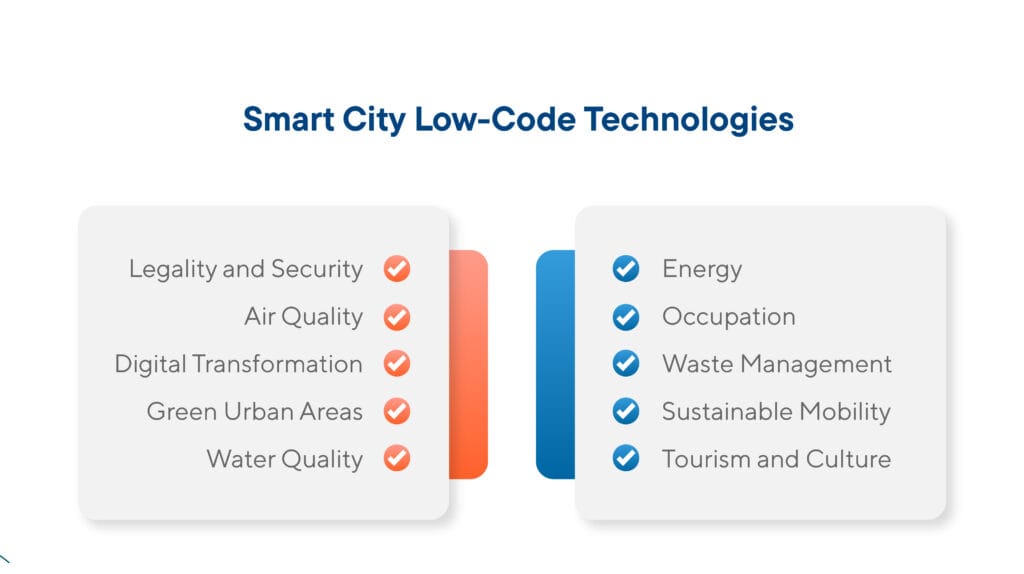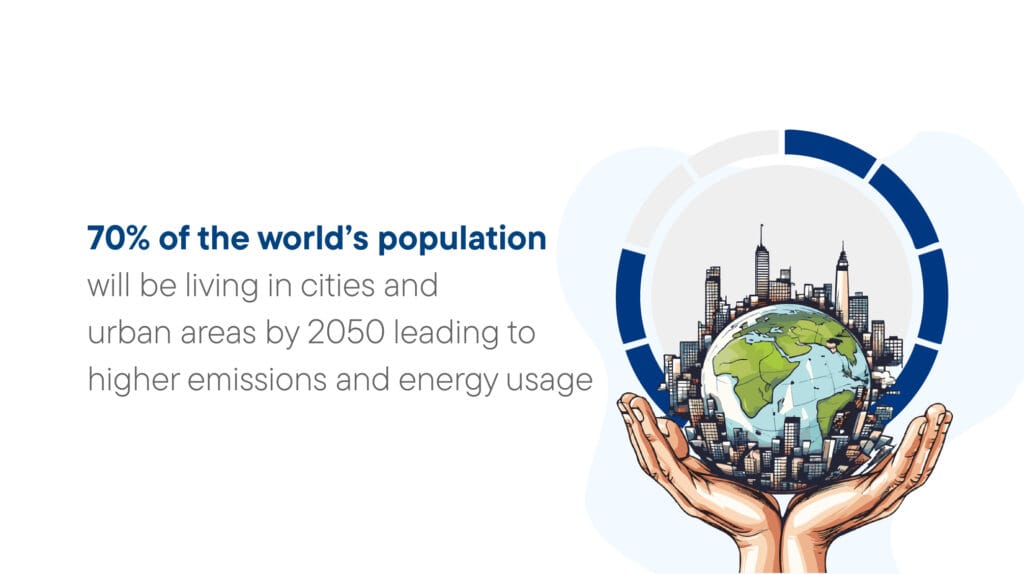The concept of smart cities is transforming urban governance. Low-code development in the public sector is enabling cities to quickly build and deploy solutions for waste management, traffic monitoring, and public safety, integrating AI, IoT, and data-driven tools.
According to 451 Research’s Voice of the Enterprise: Internet of Things, the OT Perspective, Use Cases and Outcomes 2023, 50% of government respondents selected ensuring public safety as the main driver for their smart city initiatives, followed by improving overall quality of life and improving city services. Rapid technological adoption is critical to accelerate the development of smart cities, ensuring these goals are met in a timely and impactful manner.
One of the biggest challenges municipalities and city administrations face is the slow pace of technology adoption. Some of the key reasons behind this are complex IT infrastructures, lengthy development cycles, and high costs. This is where low-code platforms are coming into picture. Unlike traditional application development, low-code platforms with their agile app development approach in government departments address challenges like high costs, low efficiency, and slow adoption by offering scalable and efficient applications. City administrations and technology officers responsible for smart city development can effectively utilize low-code applications to create public service platforms, improve citizen engagement, and create sustainable, future-ready cities.
How Low-Code Development Can Enhance Smart City Development and Management?
A Smart city’s success relies on interconnected technologies that enhance urban living, streamline operations, and ensure sustainability. However, traditional IT development is often too slow and expensive to keep up with rapid urbanization.
There are multiple benefits of low-code platforms in public services including:
- Align with e-governance goals by enabling public sector agencies to achieve digital transformation more rapidly, enhancing service delivery and citizen trust.
- Develop and deploy smart city technologies faster without needing extensive programming expertise.
- Integrate the new technologies and applications with existing databases, IoT devices, and legacy systems.
- Automate workflows and leverage real-time insights for smarter decision-making.
- Streamline Interagency collaboration to work on the same unified platform, improving collaboration and information sharing. Teams from multiple departments can work together in real-time, ensuring efficient workflows & reducing redundancies.
With drag-and-drop functionality, pre-built templates, and AI-assisted development, city administrators can easily start digital transformation in the public sector. Building and modifying applications becomes almost 10x faster, ensuring that urban services evolve in real time with citizens’ needs.
Key Areas Where Low-Code Applications Can Enhance Public Services

Infrastructure Management & Maintenance
Cities rely on vast infrastructure networks, from roads and bridges to energy grids and waste management systems. In smart cities, these tasks are digitized and performed using forms, intuitive tools, and maintenance dashboards. However, building smart city technology applications with traditional methods is time-consuming and expensive. Low-code applications enable cities to complete these tasks in weeks instead of months, reducing downtime and repair/maintenance costs. Additionally, low-code platforms streamline public service delivery management by enabling real-time monitoring, predictive maintenance, and automated workflows.
Traffic and Transportation
Congestion and inefficient public transport are major urban challenges. Low-code application development optimizes urban mobility by integrating real-time data from traffic sensors and GPS tracking systems. For example, a low-code-powered metro and bus fare management system can use data visualization tools to track ridership patterns, enable digital ticketing, and cashless payments. Unlike traditional development approaches, which are time-consuming and resource-intensive, low-code platforms in government allow such systems to be developed and deployed in a fraction of the time & scale as required.
Environmental & Energy

Sustainability is a core focus for modern cities, and low-code applications help monitor and optimize environmental factors. Technologies like smart grids powered by low-code applications enable energy providers to track & monitor consumption, reduce waste, and improve distribution efficiency. These applications can also leverage AI and intuitive tools to monitor tasks like water conservation efforts or emissions levels of various areas of the city.
Public Safety & Emergency Response
Low-code applications streamline emergency response by automating workflows and improving coordination between public-centric agencies. These purpose-built applications enable real-time tracking of incidents, resources, and personnel, ensuring faster and more effective decision-making during emergencies. With low-code, cities can quickly deploy solutions for public safety, reducing response times and enhancing citizen security.
Conclusion
Smart cities require agile, scalable, and cost-effective solutions to keep up with rapid urbanization and growing citizen demands. Through low-code development, municipalities can easily get access to tools to streamline public services, optimize infrastructure, and enhance sustainability—all while reducing development time and costs. Low-code technology enables cities to implement data-driven technological solutions at a fraction of time.
With iLeap’s low-code solutions, urban developers and city officials can accelerate digital transformation in the public sector without complex coding requirements. iLeap’s platform integrates cutting-edge technologies such as AI, IoT, and automation, helping municipalities build smarter, more responsive cities that can adapt to evolving challenges in smart city implementation. As cities continue to grow & expand at scale, adopting low-code technology is no longer an option—it is a necessity for future-ready urban management.
Contact our experts to learn more or sign up for a free demo.
